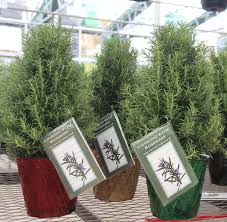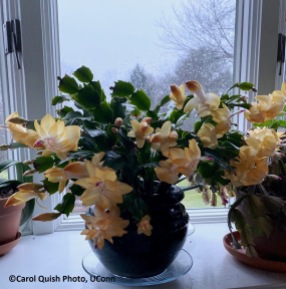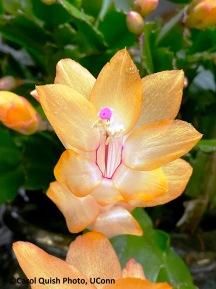
Did you receive a plant during this holiday season? Poinsettia, holiday cactus and rosemary trees are filling the shelves in greenhouses, grocery stores and even big box stores appealing to the giver to gift a plant lover on their list. While they are beautiful plants, they will need the correct care to keep them that way and in good health.
The familiar red foliage of the poinsettia plant are modified leaves called bracts. They surround the actual small, yellow flower at the center of the red bracts. Once the pollen from the flowers are shed, the bracts are dropped from the plant. Chose plants with little to no pollen for the bracts to be retained for a longer length of time. Plant breeders are developing different colored bracts, including variegated, offering many options than just red.
Poinsettias should be treated as houseplants as they are native to Mexico and will not tolerate cold temperatures. Keep the plants out of the way of drafts and not near cold windows. They prefer six hours of indirect light daily, and inside temps of 60 to 70 degrees F during the day, with night temps a little cooler. Water when the soil is dry, then drain excess from saucer or foil wrapping. Remove the foil wrapping to increase airflow to roots. Continuously wet soil will invite root rot, a common killer of poinsettia. Fertilizer once per month whenever the plant is not in bloom. Plants can be moved outside for a ‘summer vacation’ as long as they are located in dappled shade. Bring them back inside before frost in the fall. To coax the plant to flower and produce red bracts again the following year, put the plant into a dark room or closet for 12 hours at time for at five to six days in a row. Provide bright light during the other 12 hours of the day. This light/dark cycle triggers the photoperiodism mechanism within the plant to flower.

Christmas cactus is another favorite holiday plant that can live for many years if properly care is given. They commonly come in shades of pink, white and even yellow. Christmas cactus (Schlumbergera x buckleyi) bloom around the end of December, and Thanksgiving cactus (Schlumbergera truncata) bloom about a month earlier. In their native environment, they live in the crotches of trees up in the forests in Central America. Known as epiphytes, they root in decomposing organic matter (leaves) which catch in tree branches. Both require the same care and dislike being overwatered. Provide well-draining potting mix such as cactus mix, and allow soil to feel dry on the surface before watering. Clay pots are a good choice for holiday cactus, and both flower better when slightly root bound.
Holiday cactus needs full sun in spring and fall, and can be placed outside in dappled shade during the summer. Fertilize with an all-purpose houseplant fertilizer once every two weeks during the summer growing season. Bring in plants before first frost and never let them be in temperatures below 50 degrees F. They will need a rest of reduced watering after flowering, usually during the winter months. Shortened days and longer nights of fall trigger the plants to set flower buds. Cooler temperatures below 68 degrees F also help buds to form. Household lights turned on can interrupt the 12 hours of darkness needed, resulting in reduced bud formation. A cool, spare room not used at night is the perfect location to initiate flower buds.

Rosemary tree. photo from University of GA
Rosemary plants pruned into the shape of an evergreen tree are popular and useful gift. The leaves are a culinary herb used in cooking. It is a tender perennial, grown outside in the summer and can be brought in for the winter treating as a houseplant. Rosemary is native to the Mediterranean area, giving a clue to its needs for good drainage, warm temperatures and good airflow. It does better in a terra cotta or clay pot rather than a plastic one. Clay allows the soil to dry out more. Set the potted plant in a south or west window to receive six to eight hours of sun each day during its inside time during the winter. I summer, sink the pot and all in hole in the garden making it easy to bring inside next fall before first frost. Repot once a year in either spring or fall as they easily become root bound. Prune whenever you need to harvest the leaves for cooking.
The biggest problem with growing rosemary indoors is powdery mildew, a whitish/grey fungal disease. Fungicides are not recommended since the plant is edible. Neem oil is the exception and can be used on light infections, then washed well before eating. Locate the plant in a spot where the plant will have lots of airflow, not be crowded, and let the soil dry out completely before watering. If the air in your home is too dry, the needled leaves will dry out. With too much humidity, powdery mildew can develop. Fertilize in the late spring when moving the plant back outside. Herbs don’t need much fertilizing and will produce better on a lean soil. Over-fertilized plants are more prone to powdery mildew infections.
-Carol Quish




